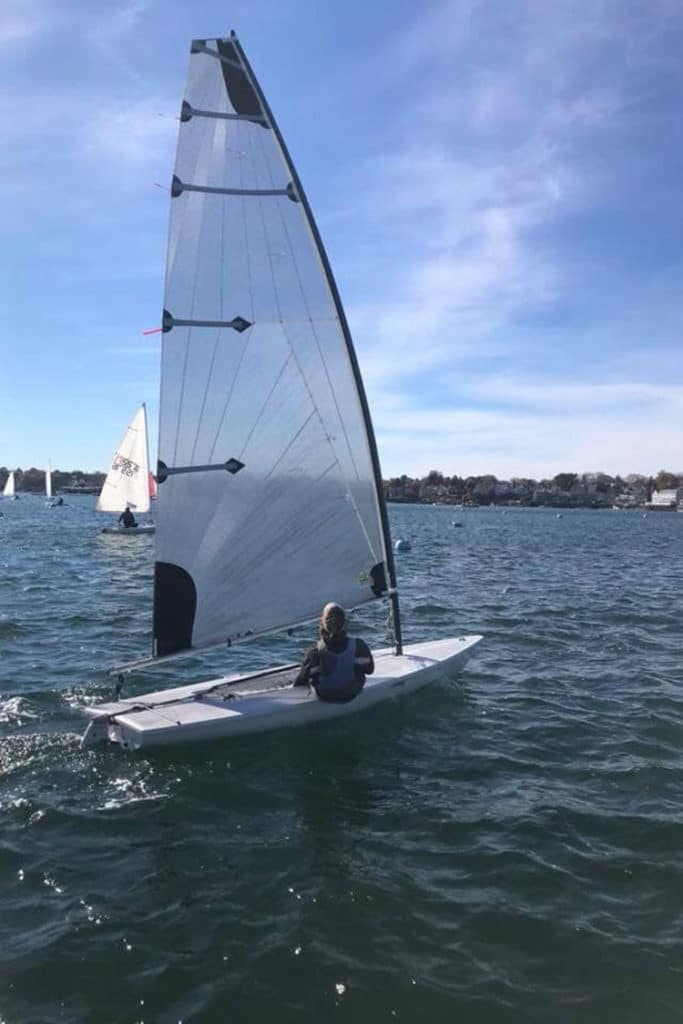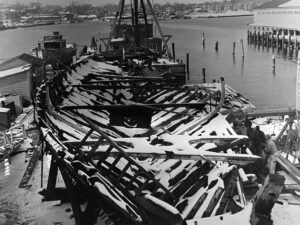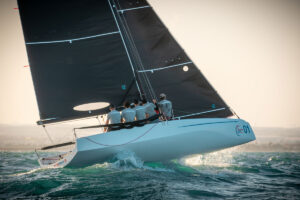With the recent activity surrounding experimentation with a new Laser rig and widespread speculation, many Laser sailors are left with a flurry of questions: Will I have to shell out big bucks for a new rig and sail for my old Laser? Will they stop making the aluminum extrusions and Dacron sails? Will I still have people to race against? Will there be a fleet for each type of rig? Are the new carbon top section and sail now obsolete? And the timing — the new rigs are appearing just as the Laser is attempting to maintain its place as an Olympic boat. If chosen, will the Olympic Laser be decked out with carbon and mylar?
To compound the confusion, there are two separate Laser entities — LaserPerformance and Laser Performance Australia — each experimenting with three different new rigs. In case you’re counting, that’s nine rigs total, including the three original rigs (Full, Radial and 4.7).
To try to get a handle on what’s going on in Laserdom, and perhaps dispel some uncertainty and achieve clarity, we spoke with Bill Crane, Chairman of the LaserPerformance Group, which is experimenting with three “ARC” rigs. We also spoke with Tracy Usher, President of the International Laser Class Association, who was able to provide information about the class’s possible direction and the Julian Bethwaite-designed Australian proposals — the C5, C7 and C9 rigs.
In January 2019, several videos went viral showing some of the new rigs, most notably the “C5” which, like the other two C-series rigs, and the three-rig ARC series, features carbon spars and a newly designed, plastic sail that looks much different than anything that has ever appeared on a Laser. The ILCA then issued a press release attempting to quash some of the more negative responses the proposals stimulated. They were adamant the rig development had no intentions of bettering their chances at the Olympic selection trials currently underway in Valencia, Spain.

“It’s kind of unfortunate timing,” says Usher, “that suddenly everything hit the airwaves right as we’re going through sea trials because the impression out there is that these are to replace the current rigs, or are being done for the Olympics. It really has nothing to do with that at all.”
Says Crane, “The timing wasn’t planned. To be honest — I did put in an Olympic tender for the ARC rig last June, despite having been advised by World Sailing that our tender would not be accepted. But the idea was that if the Laser were chosen as the Olympic equipment, we would then be in line to be an evolutionary product, if World Sailing and the class thought it was time to move forward. If you don’t put that in, chances are you won’t have that opportunity.”
Crane says the idea of moving the Laser up the evolutionary ladder originated at least four years ago at an ILCA technical committee meeting. “We had talked about the need to move the Laser along, but we hadn’t been getting a lot of traction with the class, other than the Mark II full-rig sail and carbon top-section.”
While those were significant advances for a class with a reputation of evolving at a glacial pace, they were still a drop in the bucket compared to what their competition in the singlehanded boat market was doing. “It’s pretty hard to watch the RS Aero come out and the Melges 14, and the Devoti D-Zero, which is in Europe,” says Crane. “These are much more contemporary designs. The Laser class has always wanted slow and methodical change when it affects performance, which I fully understand. But at some point, we have to take it up a notch.”
The Laser has numbers on its side, with more than 215,000 built, and, according to Crane, probably 100,000 of them still sailing. They’re found in every continent except Antarctica. However, Henry Ford could have made the same argument for the Model T, and many of us might still be driving them only because they were ubiquitous. But we’ve moved on, which Usher acknowledges. “Name a class that is still going strong, is 50 or 100 years old, and looks like it did when it first started out,” he says. “You have to keep looking forward and keep yourself relevant.” That’s what the class is trying to do.”
Crane credits the Laser’s designer, Bruce Kirby, for “an awesome job designing the boat.” But they’re still building them the way they were in 1971. “The world has moved on,” he says. “The hull, that will be trickier, but the rig, we can do.”
At the November 2018 Laser World Council meeting, Bethwaite’s testing program was given the green light. The main focus was the 4.7. “In Europe, the 4.7 has had tremendous success,” says Usher. “Then, kids move into Radials or full rigs, depending on their size. But the same kind of thing’s not happening in the rest of the world. There is a whole category of lightweight adult sailors, and the 4.7 or Radial are not right for them. I should add that the Japanese builder, for as long as I can remember, has been championing some way to make a rig that was for lighter-weight sailors. The question for Bethwaite was, can you design something that will slot between the 4.7 and Radial, and appeal to sailors we’re not capturing now.”
RELATED: The Zen of Rigging a Sailboat
Meanwhile, LaserPerformance decided to take on the other sails, says Crane, to provide sailors with an option. “We were not aware the Australians had done the other two rigs. I thought they were just working on the small rig, and suddenly the video came out showing their three rigs, which was a bit of a surprise. Then, we decided we’d show them what we were doing. We hadn’t brought it to the class at that point because we didn’t want to disturb things, right when they’re looking at picking a new boat for the Olympics.”
Crane’s plan includes contemporary Full and Radial rigs. “We broadened the weight range so that heavier and lighter men and women could be competitive,” he says. “We came up with a rig that was rather stiff down low, but much more flexible up high. The sail has much more high-aspect ratio, which means you can really twist the top off when it’s windy. We’ve tested it, and it really works.”
Crane emphasizes they’re not going to get rid of the Radial or Full rig, but as Usher noted, they “need to start moving the Laser forward, and the rate of evolution has to increase.”
A big challenge for the Laser class is that the boat is being sailed much differently than Kirby could ever have envisioned, and modifications to the original sail controls have created unintended consequences, especially for those racing at the highest levels of competition. “It was fine when Hans Fogh’s 3.2-ounce Dacron sail came out and there was just a 3-to-1 vang and 3-to-1 cunningham,” says Crane. “But then people started tying loops in those controls, creating a lot more purchase, and sail life rapidly diminished.”
To address that, the class switched to sails made of 3.8-ounce Dacron. “All of a sudden, the top sections started to bend, and everyone was blaming the manufacturer,” says Crane. “We upped the spar alloys as high as we could without driving the price out of the realm of reality.”
Then came a vang and cunningham system that allowed significant amounts of tension to be applied with considerably less effort, and the 3.8-ounce Dacron sail suffered the fate of its predecessor. The response? The 4.5-ounce Mark II sail, which checked the box for sail durability, but did no favors when it came to the top section. The stronger sail, coupled with heavy cunningham load, dramatically increased pressure on the rivets holding the top-section mast collar, and the rivets began to fail. Plus, top sections continued to break.
The solution was a carbon top section with a molded collar to address the rivet issue, and the carbon construction provided a tube much less prone to breakage.
“Now, we’re starting to see some of the lower masts starting to bend, not so much in the full rigs, but on the Radial,” says Crane. And so, we’re in the process of doing a composite lower for the Radial.”
Given the domino-effect created by attempting to stay modern, it’s not surprising that the class wants to hit the reset button. But there’s more to it. “The goal is to possibly introduce a new rig to appeal to a new group of people,” says Usher.
“There will be some crossover, I’m sure. Maybe eventually, everybody will say, ‘Wow, these things are a lot cooler, and that’s what we want to do.’ But we’re not going to force that on people.”
Crane agrees. “I think it’s one of those things where, if you can get it launched and people buy it, the younger people who are going to get in the Radial might think it’s cooler.”
Usher does not anticipate much incentive to switch from one rig to another, “Unless you’re a sailor coming up and you buy into one or the other, and you stay on that path. And if you buy the rig with the boat, I think the price will be close. But the key is it does actually make the boat sail better.”
With testing ongoing in Australia and Japan, Usher says that the World Council meeting in November 2019 will determine the next steps — if any. “Remember, the Laser class is notoriously slow at making changes,” says Usher. “If I were out there sailing a Laser, I wouldn’t hold my breath for a new rig to show up.”









